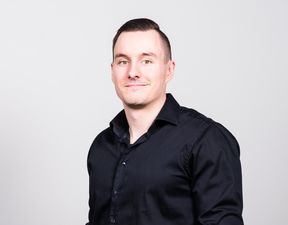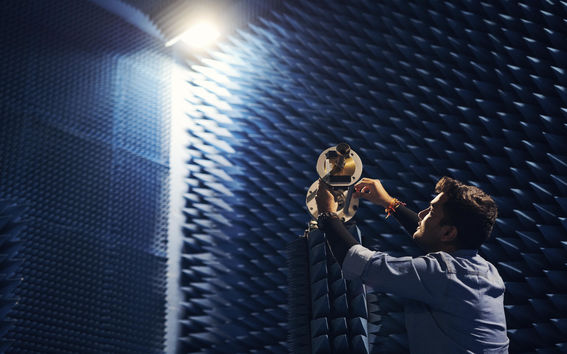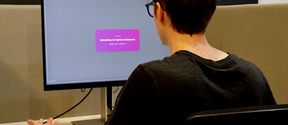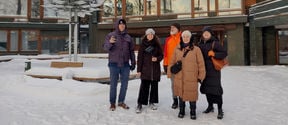Electronics and Nanotechnology, Master of Science (Technology)
By developing modern hardware technology, electronics and nanotechnology experts play a key role in shaping the future.

The Finnish Physical Society (FPS) has awarded Mathias Fontell the Young Physicist Prize 2019 for his master's thesis in space technology. Fontell earned his master's degree from Aalto University in 2019.
Fontell's award-winning work is a guide to solving propagation problems concerning long-distance radio waves in the upper strata of the atmosphere known as the ionosphere. The guide can be used by people who work within long-distance telecommunications. The ionosphere has very complex refractive properties and temporally highly varying structure which makes propagation problems difficult to solve.
Fontell's interest in ionospheric radio propagation was sparked during his military service where he received training on radio techniques. The Finnish Defence Forces use the ionosphere for secure communications. In the upper layers of the atmosphere, radio wave propagation is based on so called skywaves, and successful radio traffic requires predicting the frequency of these waves. Fontell noticed that successful communication is largely dependent on the operator's technical competence. He was eager to understand why radio waves sometimes successfully travelled through the ionosphere and sometimes failed to reach their destination.
‘I noticed that some days it was easy to establish links, but on other days, no matter what you did, the ionosphere would stay completely silent and unresponsive ‘, Fontell says.
During his studies at Aalto University, Fontell was offered the opportunity to work as part of the project group of the Suomi 100 satellite. Suomi 100 is a nanosatellite that was built at Aalto University and launched into space in December 2018. The satellite was equipped with a radio measuring device for ionospheric research.
Due to his interest in radio propagation sparked in the army, Fontell wanted to analyse and model the skywave data sent by the satellite. To be able to analyse the measurement data, Fontell needed an understanding of several fields of physics and electrical engineering, so he began to familiarise himself with literature related to ionospheric radio propagation. He received help from his supervisor, Esa Kallio, Professor of Space science and technology at Aalto University. When exploring the topic, Fontell and Kallio found that the theory was so complex that people who did not have specific expertise in the field would have difficulties in applying it.
In his work, Fontell used a method published by British radiophysicist Jenifer Haselgrove (1954). Haselgrove found that skywaves can be modelled as particles rather than waves due to their high frequencies. The topic was complicated and Fontell felt that in later works on the subject the functioning of the method was not explained to the reader in a sufficiently clear manner. In order to solve radio wave propagation problems, it was also necessary to comprehensively understand fields requiring special expertise, such as antenna radiation patterns, ionosphere structure, modern numerical algorithms and low-level software design. This disturbed the young researcher, and he believed that with the help of modern technology he could write a guide that would give researchers a good overall picture of the topic even if they did not have special expertise in this particular field. The aim was to clarify the key concepts related to problem solving in radio wave propagation and present applicable methods.
‘I wanted to create a practical and comprehensive guide that a person with a technical education could use when encountering a problem without having to go through a huge amount of scientific literature’, Fontell says.
Fontell worked on his thesis for about six months. He found working on the topic educational and fun, as the work was a mixture of theory and creative programming that he had been able to practise as part of his studies at Aalto University. He designed the scientific computing software from scratch and created everything from the architecture to dependencies, data structures and algorithms.
After graduating, Fontell started working as a software engineer at Space Systems Finland, now known as Huld. In his current role, he has produced performance-critical data processing software for an atmospheric monitoring satellite maintained by the European Space Agency. The skies also fascinate Fontell in his free time, and he has recently started training to become an amateur pilot.
‘I consider myself very fortunate for having to opportunity to work in the space technology industry, and the excellent study programme in Space Technology at Aalto University has helped make this dream a reality for me. In the near future, I am hoping to return to academia in pursuit of a doctoral degree in space technology, he says.
The Finnish Physical Society annually awards the Young Physicist Prize to the author of an excellent master's thesis in the field of physical sciences. The purpose is to support young physicists and reward them for exceptional performance. The prize comprises EUR 1,000 and free membership of the Finnish Physical Society for the current year. The 2019 prize was shared between Fontell and Markus Hiekkamäki with a MSc (Tech.) degree from Tampere University.
Watch the video below to get a better look at the research. Fontell has made the video for the Finnish Physical Society for the Young Physicist Competition.
Mathias Fontell
[email protected]
Professor Esa Kallio
Supervisor
[email protected]

By developing modern hardware technology, electronics and nanotechnology experts play a key role in shaping the future.



